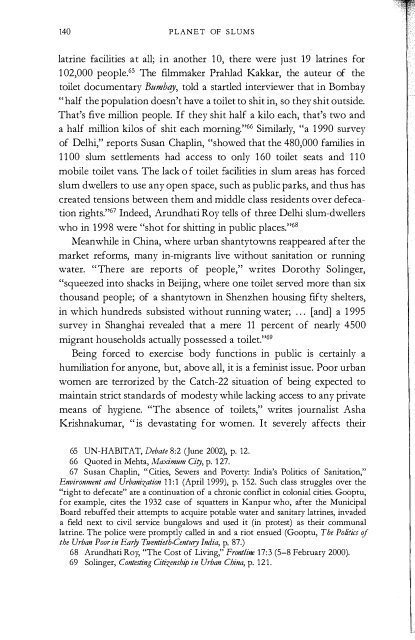Untitled - Rebel Studies Library
Untitled - Rebel Studies Library
Untitled - Rebel Studies Library
You also want an ePaper? Increase the reach of your titles
YUMPU automatically turns print PDFs into web optimized ePapers that Google loves.
140 PLANET OF SLUMS<br />
latrine facilities at all; in another 10, there were just 19 latrines for<br />
102,000 people.65 The filmmaker Prahlad Kakkar, the auteur of the<br />
toilet documentary Bumbay, told a startled interviewer that in Bombay<br />
"half the population doesn't have a toilet to shit in, so they shit outside.<br />
That's five million people. If they shit half a kilo each, that's two and<br />
a half million kilos of shit each morning."66 Similarly, "a 1990 survey<br />
of Delhi," reports Susan Chaplin, "showed that the 480,000 famiJies in<br />
1100 slum settlements had access to only 160 toilet seats and 110<br />
mobile toilet vans. The lack of toilet facilities in slum areas has forced<br />
slum dwellers to use any open space, such as public parks, and thus has<br />
created tensions between them and middle class residents over defecation<br />
rights."67 Indeed, Arundhati Roy tells of three Delhi slum-dwellers<br />
who in 1998 were "shot for shitting in public places."68<br />
Meanwhile in China, where urban shantytowns reappeared after the<br />
market reforms, many in-migrants live without sanitation or running<br />
water. "There are reports of people," writes Dorothy Solinger,<br />
"squeezed into shacks in Beijing, where one toilet served more than six<br />
thousand people; of a shantytown in Shenzhen housing fifty shelters,<br />
in which hundreds subsisted without running water; ... [and] a 1995<br />
survey in Shanghai revealed that a mere 11 percent of nearly 4500<br />
migrant households actually possessed a toilet."69<br />
Being forced to exercise body functions in public is certainly a<br />
humiliation for anyone, but, above all, it is a feminist issue. Poor urban<br />
women are terrorized by the Catch-22 situation of being expected to<br />
maintain strict standards of modesty while lacking access to any private<br />
means of hygiene. "The absence of toilets," writes journalist Asha<br />
Krishnakumar, "is devastating for women. It severely affects their<br />
65 UN-HABITAT, Debate 8:2 (June 2002), p. 12.<br />
66 Quoted in Mehta, Maximum City, p. 127.<br />
67 Susan Chaplin, "Cities, Sewers and Poverty: India's Politics of Sanitation,"<br />
Environment and Urbanization 11:1 (April 1999), p. 152. Such class struggles over the<br />
"right to defecate" are a continuation of a chronic conflict in colonial cities. Gooptu,<br />
for example, cites the 1932 case of squatters in Kanpur who, after the Municipal<br />
Board rebuffed their attempts to acquire potable water and sanitary latrines, invaded<br />
a field next to civil service bungalows and used it (in protest) as their communal<br />
latrine. The police were promptly called in and a riot ensued (Gooptu, The Politics of<br />
the Urban Poor in Early Twentieth-Century India, p. 87.)<br />
68 Arundhati Roy, "The Cost of Living," Frontline 17:3 (5-8 February 2000).<br />
69 Solinger, Contesting Citizenship in Urban China, p. 121.<br />
SLUM ECOLOGY<br />
dignity, health, safety and sense of privacy, and indirectly their literacy<br />
and productivity. To defecate, women and girls have to wait until dark,<br />
which exposes them to harassment and even sexual assault."70<br />
In the slums of Bangalore - the high-tech poster city for "India<br />
Shining" - poor women, unable to afford the local pay latrines, must<br />
wait until evening to wash or relieve themselves. Researcher Loes<br />
Schenk-Sandbergen writes:<br />
Men can urinate a t any time a t any place, whereas women can only be<br />
seen following the call of nature before sunrise and after sunset. To<br />
avoid hazards, women have to go in groups at five o'clock in the<br />
morning ... often [to] marshy land where snakes would be hiding, or<br />
some deserted dumping ground with rats and other rodents. Women<br />
often say that they do not eat during the daytime just to avoid having to<br />
go to the open field in the evening.71<br />
Similarly, in Bombay women have to relieve themselves "between<br />
two and five each morning, because it's the only time they get privacy."<br />
The public toilets, explains the writer Suketu Mehta, are rarely a solution<br />
for women because they seldom function: "People defecate all around<br />
the toilets, because the pits have been clogged for months or years."72<br />
The solution to the sanitation crisis - at least as conceived by certain<br />
economics professors sitting in comfortable armchairs in Chicago and<br />
Boston - has been to make urban defecation a global business. Indeed,<br />
one of the great achievements of Washington-sponsored neoliberalism<br />
has been to turn public toilets into cash points for paying off foreign<br />
debts - pay toilets are a growth industry throughout Third World slums.<br />
In Ghana a user fee for public toilets was introduced by the military government<br />
in 1981; in the late 1990s toilets were privatized and are now<br />
described as a "gold mine" of profitability.73 In Kumasi, for instance,<br />
where members of the Ghanaian Assembly won the lucrative contracts,<br />
70 Asha Krishnakumar, "A Sanitation Emergency," Focus 20:24 (22 November<br />
S December 2003).<br />
71 Loes Schenk-Sandbergen, "Women, Water and Sanitation in the Slums of<br />
Bangalore: A Case Study of Action Research," in Schenk, Living in India's Slums, p. 198.<br />
72 Mehta, Maximum City, p. 128.<br />
73 Deborah Pellow, "And a Toilet for Everyone!," in Mills-Tetley and Adi-Dako,<br />
Visions of the City, p. 140.<br />
141


